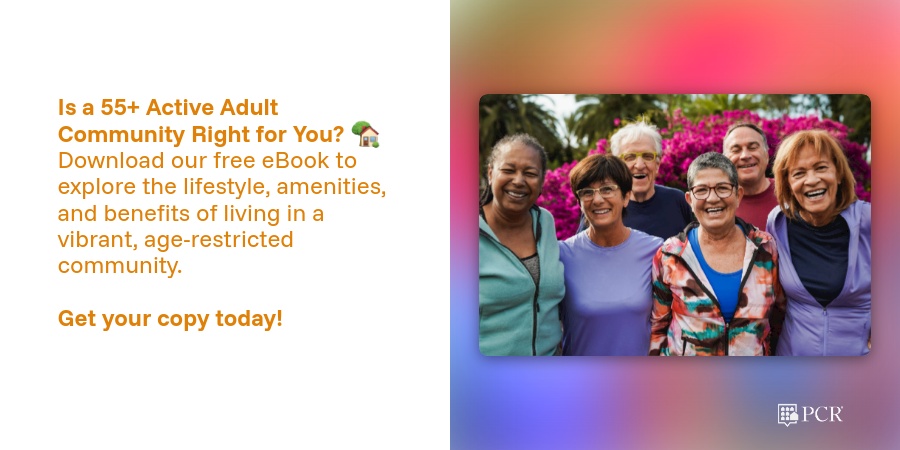by Robert Borges on September 17, 2024
You’ve worked hard your entire life, and as retirement nears, you might find yourself ready for a new chapter. Whether you're downsizing, looking to simplify, or seeking a more social, active lifestyle with peers of similar interests, 55+ communities could be the perfect solution. But before diving in, you may wonder, how are 55+ communities legal?
Age-restricted housing may seem like a form of discrimination, but it’s actually not. These communities operate within the bounds of the law, thanks to certain provisions that make exceptions to the general rules prohibiting age-based discrimination. This article will unpack how 55+ communities are legal, who can live in 55+ communities, what their regulations entail, and how they fit into broader housing laws.
Understanding the Legality of 55+ Communities

Federal Fair Housing Act and Exemptions
The Federal Fair Housing Act (FHA), part of the Civil Rights Act of 1968, prohibits discrimination in housing based on race, color, national origin, religion, sex, disability, and familial status. Notably, age is not included in this list, which is a key point when considering how 55+ communities are legal. The FHA's primary focus is to ensure that people are not excluded from housing opportunities because they belong to a protected class. However, in 1995, the Housing for Older Persons Act (HOPA) was passed, creating an exemption specifically for senior housing.
HOPA amended the Fair Housing Act to allow age-restricted communities to operate legally if they meet certain criteria. For a community to qualify under this exemption, it must follow specific guidelines, primarily ensuring that at least 80% of the occupied units have at least one person aged 55 or older. This 80/20 rule has become a cornerstone of how age-restricted communities remain in compliance with federal laws while fostering an environment tailored to older adults.
The Housing for Older Persons Act (HOPA)
HOPA solidified the legal framework that permits 55+ communities to exist without violating anti-discrimination housing laws. So, how are 55+ communities legal within the context of HOPA? The act provides a clear path: as long as the community adheres to the rules that ensure it is intended for older people, it can limit residency based on age. Specifically, the community must:
- Have at least 80% of its units occupied by one resident who is 55 or older.
- Clearly show an intent to provide housing for people aged 55 and above, typically through marketing and community rules.
- Maintain policies and procedures to enforce age restrictions, such as documentation proving the age of residents.
By following these requirements, 55+ communities stay within the bounds of federal law while offering a specialized living environment for seniors.
55+ Community Rules and Requirements

When exploring how 55+ communities are legal, it’s important to understand the common rules and regulations these communities have in place. While specific rules can vary, the following guidelines are fairly standard when considering who can live in a 55-plus community:
- Age Requirements: At least one resident must be 55 or older in every household. This ensures compliance with the 80/20 rule outlined by HOPA.
- Other Residents: Most communities allow spouses or partners who are under the age of 55 to live in the home, with the minimum age often set at 40. Children, on the other hand, are generally not permitted to live in these communities full-time, though there are exceptions for short-term visits.
- Children in 55+ Communities: Most 55+ communities do not allow children to live in the home permanently. However, they do make allowances for visits from younger family members, including grandchildren. It’s common for communities to impose a time limit on how long children can stay—usually anywhere from two weeks to 30 days—depending on the community’s specific rules.
- The 80/20 Rule: As mentioned earlier, the 80/20 rule requires that 80% of units have at least one resident aged 55 or older. The remaining 20% allows for some flexibility. For instance, if a resident passes away, and their under-55 spouse is left in the home, they are generally allowed to continue living there under this rule. The intent is to prevent families from being displaced due to unforeseen circumstances.
These rules ensure that the community remains focused on serving seniors while providing a supportive environment where older adults can thrive among their peers.
How Do 55+ Communities Enforce Age Restrictions?
When considering how are 55+ communities legal, it’s helpful to look at how they enforce these age-based restrictions as age verification is a key part of the process. Communities often require potential residents to provide documentation proving their age, such as a birth certificate, driver’s license, or passport. Some communities may also request annual updates or conduct periodic reviews to ensure compliance.
Additionally, communities can enforce their rules through homeowner associations (HOAs) or property management companies. These entities are responsible for making sure residents comply with all community regulations, including age restrictions. Failure to meet these requirements could result in fines or other penalties.
Pros and Cons of 55+ Communities

Now that we’ve established the legality of 55+ communities, let’s weigh some of the benefits and potential drawbacks to help you decide whether or not a 55+ community is right for you.
Pros
- Community Atmosphere: Residents are surrounded by peers in the same life stage, which fosters a sense of belonging and understanding. Georgia’s premier 55 plus communities are a great example.
- Amenities and Activities: Most 55+ communities offer resort-style amenities, including pools, golf courses, fitness centers, and social clubs. These make it easier for residents to stay active and engaged, as they do in these 55+ communities in SC.
- Low Maintenance Living: Many 55+ communities offer low-maintenance or maintenance-free living, freeing up time for leisure activities and travel. So even if you’re looking for a 55+ community in fall foliage retirement destinations, you won’t have to worry about all the yard work and leaf raking that comes with it!
Cons
- Age Restrictions: While these restrictions create a peaceful environment of like-minded neighbors, they may feel limiting to some, particularly if you wish to live with younger family members or if children play a significant role in your day-to-day life.
- HOA Fees and Rules: Some communities come with high HOA fees, and residents must adhere to a strict set of rules, which may not appeal to everyone.
Where to Find 55+ Communities

Now that we’ve described how 55+ communities are legal, you may be wondering where to find one. These communities can be found across the U.S., from traditional retirement hotspots like Florida and Arizona to less typical locations like mountain towns and lakeside retreats. Whether you prefer a desert climate, coastal living, or proximity to urban centers, there’s likely a 55+ community to suit your needs.
Start your search with PCR! Explore our vast network of 55+ communities throughout the country, see photos, discover amenities, find homes for sale, and request more information directly from your communities of interest. Find your 55+ community here.

